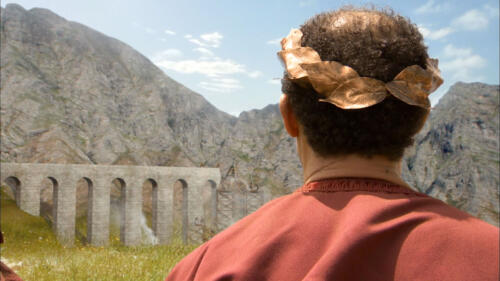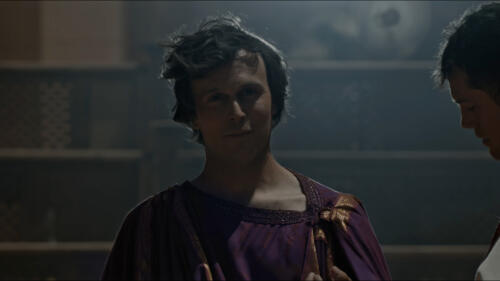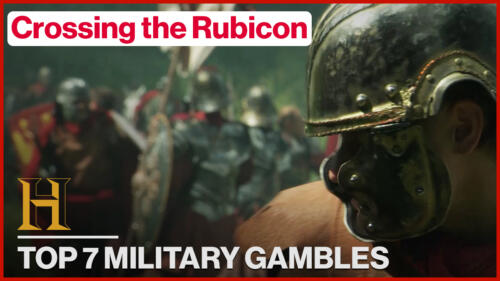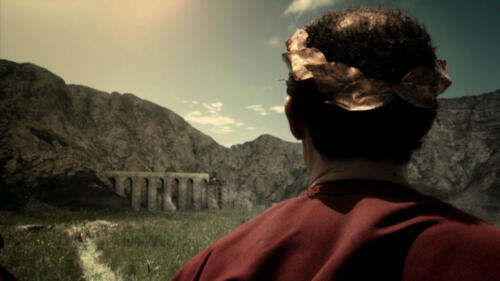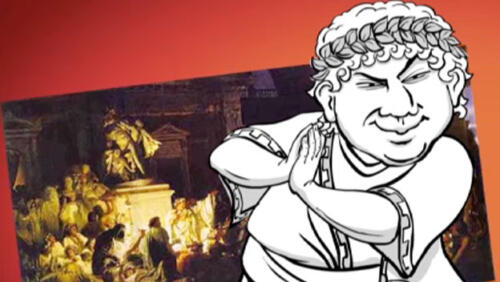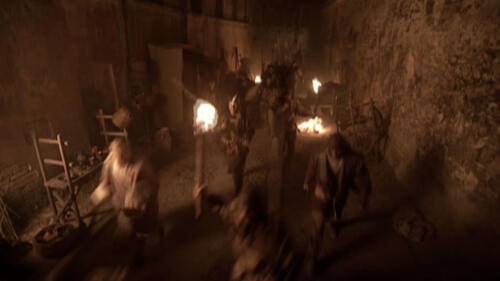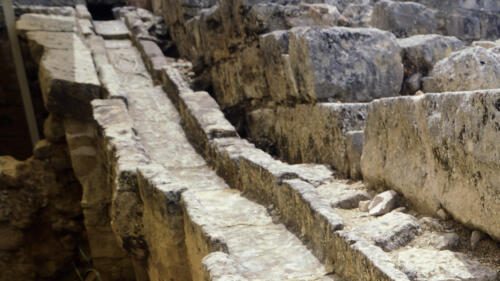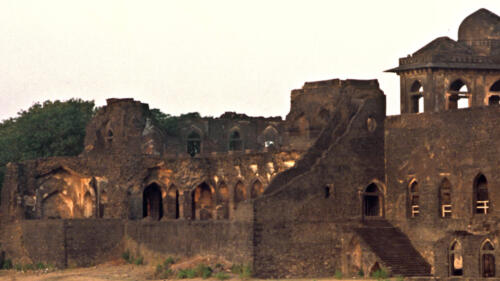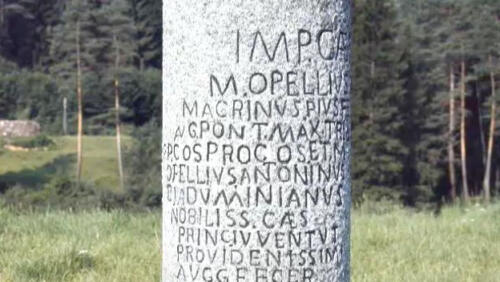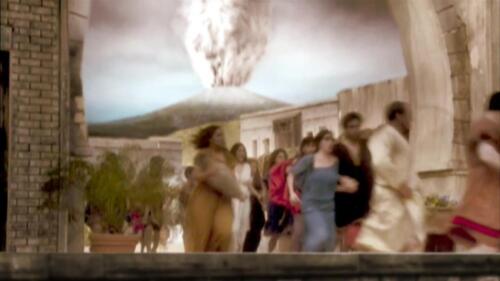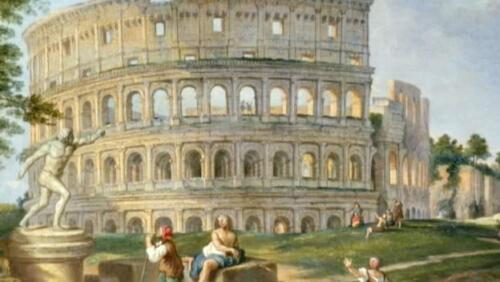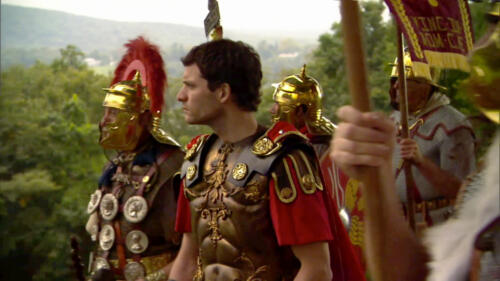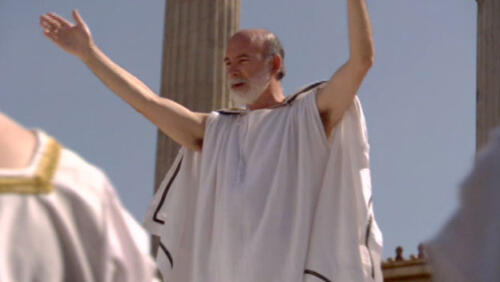Ancient Rome
Ancient Rome—first a republic and then an empire led by rulers such as Julius Caesar, Augustus Caesar, Caligula and Nero—was a vast and powerful domain that gave rise to the culture, laws, technologies and institutions that continue to define Western civilization.
Featured Overview
All roads lead to Rome - and so do these tech trees! From the newspaper to the vending machine, these are 8 amazing Roman technological innovations, in this episode of History Countdown.
8:42m watch

Illustration by Eduardo Ramón Trejo. Photos from Getty Images.
Featured Overview
All roads lead to Rome - and so do these tech trees! From the newspaper to the vending machine, these are 8 amazing Roman technological innovations, in this episode of History Countdown.
8:42m watch
Start Here

These rulers were often as innovative and ingenious as they were brutal and corrupt.

Their lives and value were defined almost solely in relation to men: their fathers and husbands. But some women found ways to claim their own power.

Find out why one of history's most legendary empires finally came crashing down.

Roman citizens could enter the arena for free to watch gladiator fights, mock naval battles, wild animal hunts—and plenty of death.
The Colosseum
Games in the Colosseum
The Roman Coliseum was an engineering marvel designed to seat close to 75,000 people.
2:22 watch

3 Architectural Wonders of Ancient Rome
Explore All Related Topics

The gladiator led an army of escaped slaves against Roman troops.

A victim of the Mt. Vesuvius eruption was lying in his bed when a searing ash cloud swept through his city. Soon, it turned out, he had a brain of glass.
Rome's emperor orders a major renovation to prove himself.
8:00m watch

Roman citizens could enter the arena for free to watch gladiator fights, mock naval battles, wild animal hunts—and plenty of death.

White flags were used during the Second Punic War in 218 B.C., and Confederate forces used a white dish towel to surrender at Appomattox.

Evidence of powerful earthquakes linked to the Vesuvius eruption adds to the story about why so many people perished at Pompeii in 79 A.D.

It’s been an Olympic event since 1984, but the sport formerly known as synchronized swimming, has ancient origins.
The construction of the largest amphitheater in Rome has taken place and now history's most iconic duels commence.
10:01m watch
Caesar consolidated his power and made himself dictator. Learn more in this exclusive clip from Ancient Empires.
5:02m watch
Two of the most known men in the history of ancient Rome are Gaius Julius Caesar and Spartacus. Learn more in this exclusive clip from Ancient Empires.
6:13m watch
Julius Caesar works his way up to becoming one of the most powerful people in Rome. see more in this clip from Season 1, Episode 2, "Caesar."
10:47m watch

He vastly expanded the ancient Roman empire, but his assassination led to its downfall.

In 218 B.C., the great Carthaginian general led his forces on a bold journey across the Alps to attack Romans on their home turf.
Commodus revolutionized what it meant to be an emperor by going against the norm and becoming a gladiator.
8:01m watch

By some historians' measure, he was the cruelest and most demented of the bunch.
When a major health crisis breaks out, a young scientist by the name of Galen is brought in to help.
8:03m watch

While doctors in ancient Rome prescribed macabre elixirs and used dreams for diagnoses, they also made significant medical advances.
An underground spiritual movement known as Christianity begins to spread through the empire.
9:48m watch

Their lives and value were defined almost solely in relation to men: their fathers and husbands. But some women found ways to claim their own power.
Gladiatorial combat takes a turn when women enter the arena.
8:13m watch

Sure, the Roman Empire had that extensive road system. But it helped that early Christians didn't paint themselves as an exclusive club.

The iconic Roman structure stood as the largest and most complex permanent amphitheater in the ancient world.

Who were the most renowned Roman gladiators? From slave rebel Spartacus to debauched emperor Commodus, they varied widely.

Chariot racing in ancient Rome showcased local teams, speed, violence and star athletes.

Roman audiences craved novelty. Females battling each other with weapons fit the bill.

These rulers were often as innovative and ingenious as they were brutal and corrupt.

Julius Caesar’s killers attempted to thwart a dictator. They inadvertently created an emperor.

During 200 years of relative peace and prosperity, the Roman Empire reached the peak of its political and economic power.
From the Battle of Marathon in 490 BCE to Operation Mincemeat in WWII, discover 7 risky gambles that ended up changing world history, in this episode of History Countdown.
8:10m watch
All roads lead to Rome - and so do these tech trees! From the newspaper to the vending machine, these are 8 amazing Roman technological innovations, in this episode of History Countdown.
8:42m watch

Among tools people used in the past were moss, sponge on a stick, ceramic pieces and bamboo 'spatulas.'

At its peak, Rome stretched over much of Europe and the Middle East.
See what the Roman Empire was like at the time of Jesus' birth in this bonus clip from "Jesus: His Life."
2:01m watch

Augustus told Romans he was the only one who could save Rome. And they believed him.

Rowdy Roman chariot-race fans wore them in imitation of the fearsome Huns. And Ben Franklin used his to send a revolutionary message to the French.

The Goths and Visigoths were Germanic tribes who fought against Roman rule, governed large swaths of territory and ushered in the the medieval period in Europe.

Hint: Miracles played an important role.

William Shakespeare might have given Marcus Junius Brutus all the credit, but Caesar's true betrayer was a much closer friend.

The Roman Forum, located in the heart of ancient Rome, was the site of religious and social activities and home to some of the city's most impressive monuments.

From ancient Rome to contemporary Paris, the flexing of military muscle is a longstanding tradition.

The Pantheon is one of the best-preserved monuments of ancient Rome. Completed circa 128 A.D., the structure features a rotunda with a massive domed ceiling.

Hadrian's Wall is the remains of a line of stone fortifications built under Roman Emperor Hadrian following the conquest of Britain in the second century A.D.

Lupercalia was an ancient pagan festival held each year in Rome around February 14. It is considered a precursor to Valentine's Day.

Saturnalia, an ancient Roman festival honoring the agricultural god Saturn, occurred in mid-December. Saturnalia rituals later became Christmas traditions.

From ancient Rome to its portrayal in popular culture, Shakespeare's famous phrase has long carried evolving symbolism and enduring significance.

Built on the orders of the Roman Emperor Hadrian and located in Great Britain, Hadrian’s Wall was a defensive fortification that marked the northwest frontier of the Roman Empire for three centuries. The wall measured 73 miles in length and stretched from coast to coast across present-day northern England, between Wallsend in the east to […]

Republican Rome was pushed to the brink of collapse on August 2, 216 B.C., when the Carthaginian general Hannibal annihilated at least 50,000 of its legionaries at the Second Punic War’s Battle of Cannae.

According to the ancient historian Suetonius, the Roman emperor known as Caligula loved one of his horses, Incitatus, so much that he gave the steed a marble stall, an ivory manger, a jeweled collar and even a house. Another chronicler, Cassius Dio, later wrote that servants fed the animal oats mixed with gold flakes. Famous […]

This Celtic queen took no prisoners after Romans annexed her family's kingdom and raped her daughters.

The word “barbarian” originated in ancient Greece, and was initially used to describe all non-Greek-speaking peoples, including Persians, Egyptians, Medes and Phoenicians. The ancient Greek word “bárbaros,” from which it derives, meant “babbler,” and was onomatopoeic: In the Greek ear, speakers of a foreign tongue made unintelligible sounds (“bar bar bar”). Similar words exist in […]

The term “Gordian knot,” commonly used to describe a complex or unsolvable problem, can be traced back to a legendary chapter in the life of Alexander the Great. As the story goes, in 333 B.C. the Macedonian conqueror marched his army into the Phrygian capital of Gordium in modern day Turkey. Upon arriving in the […]
Ancient Rome waged many campaigns of conquest during its history, but its most influential wars may have been the ones it fought against itself.

Take a look back at six of the most damaging raids on the Eternal City.

From Genghis Khan to Alexander the Great, get the facts on seven historical titans whose final resting places are unaccounted for.

A replica of the lift system used to hoist and release deadly wild animals onto the Colosseum’s floor has been unveiled inside Rome’s ancient amphitheater.

A new examination of Julius Caesar’s health has found that the Roman dictator may have suffered from a series “mini-strokes” rather than epilepsy.

An ancient city that manages to stay inhabited—and important—over thousands of years is a surprisingly rare occurrence. Here are six of the most fascinating examples.

Explore eight surprising facts about the life of Rome’s fourth emperor.

Explore eight illuminating facts about the first Roman emperor.

Whether revered as a divine symbol of luck and wisdom, used as unique tools of diplomacy between leaders, deployed to intimidate opposing armies or put on display in the service of status or science, elephants have loomed large in the historical record.

Equal parts secret service, special forces and urban administrators, Rome’s Praetorian Guard was one of the ancient world’s most prestigious military units.

Explore eight reasons why this remarkable transit system helped unite the ancient world.

Get the facts on the enigmatic men-at-arms behind Ancient Rome’s most notorious form of entertainment.

Find out why one of history's most legendary empires finally came crashing down.

Find out five fascinating facts about the man who famously proclaimed “I came, I saw, I conquered.”

By analyzing concrete used to build 2,000-year-old Roman structures, a team of scientists discovered why it's so durable.

Nero had many enemies and is remembered as one of history’s most sadistic and cruelest leaders. But there are a couple of problems with the story.

You’ve heard all about them, but how much of the vomitorium story is mere myth?

The Romans were prodigious builders and expert civil engineers, and their thriving civilization produced advances in technology, culture and architecture that remained unequaled for centuries.
Rome delivered fresh water to its people by building massive aqueducts that are still an engineering marvel today.
2:53m watch

Find out whether the much-maligned emperor was as crazy as they say.
Did Nero fiddle while Rome burned? Get the full story
2:04m watch
in 410 A.D. Alaric and the Visigoths sack Rome after years of holding the city under siege.
3:19m watch
See how civilizations throughout history have designed and managed their plumbing and waste disposal systems.
4:09m watch
Ancient rulers built luxurious private residences that rival modern-day mansions.
3:41m watch
A surprising innovation may have helped the Carthaginians cross the snow-covered terrain of the Alps.
3:22m watch
The Appian Way is the world's first super highway and brought us the first milestone, marking the distance traveled along the road.
1:34m watch
It was nearly wiped out during the eruption of Mount Vesuvius in 79 A.D. What is left of this ancient city and will Vesuvius erupt again? Uncover the lost city of Pompeii.
2:17m watch
The Roman Coliseum was an engineering marvel designed to seat close to 75,000 people.
2:22m watch
The eruption of Mount Vesuvius in 79 A.D. obliterated the Roman city of Pompeii, burying it under tons of volcanic ash. While many of its resident fled to safety, what happened to those who dared to stay behind?
2:14m watch
The Roman leader Julius Caesar was stabbed 23 times by a mob of mutinous senators in 44 B.C. Could he possibly have survived long enough to utter his famous last words?
2:01m watch
Built as a temple for the Goddess Athena, the Parthenon is considered one of the greatest examples of Greek architecture still standing today.
4:47m watch

Pompeii and Herculaneum were flourishing resorts on the coast of Italy until Mount Vesuvius erupted in 79 A.D., burying the cities’ ruins under tons of ash and rock.

Mark Antony was a Roman politician and general known for his alliance with Julius Caesar, his rivalry with Octavian and his affair with Egypt's Queen Cleopatra.

Marcus Cicero (106-43 B.C.) was a Greek philosopher who was considered the greatest orator of the late Roman Republic. Cicero was one of the leading political figures in the era of Julius Caesar, Pompey, Marc Antony and Octavian. It was through him that the thinkers of the Renaissance and Enlightenment discovered the riches of Classical rhetoric and philosophy.

Caligula (formally known as Gaius) was the third of Ancient Rome’s emperors, who achieved feats of waste and carnage during his four-year reign (A.D. 37-41).

Known for his philosophical interests, Marcus Aurelius was one of the most respected emperors in Roman history. His greatest intellectual interest was Stoicism, a philosophy that emphasized fate, reason and self-restraint.

Nero Claudius Caesar (37-68 A.D.) was one of Rome’s most infamous emperors, who ruled from 54 A.D. until his death by suicide 14 years later. Emperor Nero is best known for his debauchery, political murders, persecution of Christians and passion for music and the arts.

Built in 70 A.D., Rome's Colosseum has been the site of celebrations, sporting events and bloodshed. Today, the amphitheater is a major tourist attraction, playing host to 3.9 million visitors each year.

Hannibal was a general and statesman of Carthage who famously led his army over the Alps in 218 B.C. during the Second Punic War with Rome.

Augustus consolidated power after the death of Julius Caesar to become the first Roman emperor and expand the reach of an empire that lasted nearly 1,500 years.

The Punic Wars, with generals like Hannibal and Scipio Africanus, were a series of battles between ancient Rome and the city-state of Carthage in North Africa.

The Seven Wonders of the Ancient World is a list of remarkable constructions of classical antiquity. Of the original Seven Wonders, only one—the Great Pyramid of Giza—remains intact.

Julius Caesar was a general, politician and scholar who became dictator of ancient Rome until he was assassinated in 44 B.C., inspiring a play by Shakespeare.

The Roman Empire, founded in 27 B.C., was a vast and powerful domain that gave rise to the culture, laws, technologies and institutions that continue to define Western civilization.
